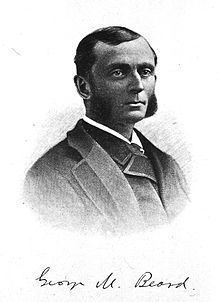Name George Beard | Education Yale University | |
 | ||
Books American Nervousness - Its Cause, A Practical Treatise on Nervous, A Practical Treatise on Nervous, Stimulants and narcotics, The psychology of the Sal | ||
Words To That Effect Podcast - 006 - Neurasthenia, Cowboys, and Feminists
George Miller Beard (May 8, 1839 – January 23, 1883) was an American neurologist who popularized the term neurasthenia, starting around 1869.
Contents
- Words To That Effect Podcast 006 Neurasthenia Cowboys and Feminists
- Biography
- Skepticism
- Publications
- References

Biography

Beard was born in Montville, Connecticut on May 8, 1839, to Rev. Spencer F. Beard, a Congregational minister, and Lucy A. Leonard. Beard's mother died in 1842 and his father remarried the following year to Mary Ann Fellowes. He graduated from Yale College in 1862, and received his medical degree from the College of Physicians and Surgeons of New York in 1866. While still in medical school during the American Civil War, he served as an assistant surgeon in the West Gulf squadron of the United States Navy aboard the gunboat New London. After the war and graduation from medical school, he married Elizabeth Ann Alden, of Westville, Connecticut, on December 25, 1866.
He is remembered best for having defined neurasthenia as a medical condition with symptoms of fatigue, anxiety, headache, impotence, neuralgia and depression, as a result of exhaustion of the central nervous system's energy reserves, which Beard attributed to civilization. Physicians who agreed with Beard associated neurasthenia with the stresses of urbanization and the increasingly competitive business environment. Stated simply, people were attempting to achieve more than their constitution could cope with. Typically this followed a short illness from which the patient was thought to have recovered.
One of the more unusual disorders he studied from 1878 onwards was the exaggerated startle reflex among French-Canadian lumbermen from the Moosehead Lake region of Maine, that came to be known as the Jumping Frenchmen of Maine. If they were startled by a short verbal command, they would carry out the instruction without hesitation, irrespective of the consequences. The studies stimulated further research by the military and Georges Gilles de la Tourette.
Beard was also involved extensively with electricity as a medical treatment, and published extensively on the subject. He was a champion of many reforms of psychiatry, and was a founder of the National Association for the Protection of the Insane and the Prevention of Insanity. He also took an unpopular stance against the death penalty for persons with mental illness, going so far as to campaign for leniency for Charles J. Guiteau, the assassin of President James Garfield on the basis that the man was not guilty because of insanity.
He died on January 23, 1883 in New York City.
Skepticism
Beard was a critic of claims of the paranormal and spiritualism which he wrote was one of history's greatest delusions. He published articles on anomalistic psychology such as The Psychology of Spiritism (1879) exposing the fraud of mediumship and describing its psychological basis.
The term "muscle reading" was coined in the 1870s by Beard to describe the methods of the mentalist J. Randall Brown.
